Related Research Articles
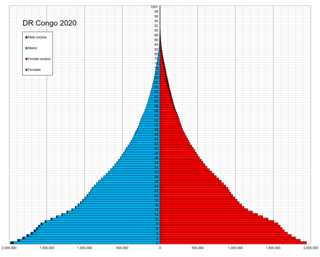
Demographic features of the population of the Democratic Republic of the Congo include ethnicity, education level, health, economic status, religious affiliations and other aspects of the population.
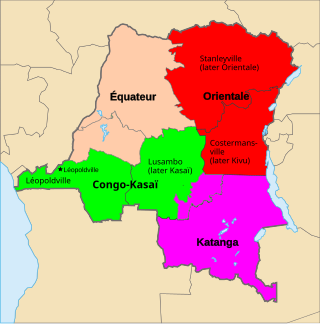
Katanga was one of the four large provinces created in the Belgian Congo in 1914. It was one of the eleven provinces of the Democratic Republic of the Congo between 1966 and 2015, when it was split into the Tanganyika, Haut-Lomami, Lualaba, and Haut-Katanga provinces. Between 1971 and 1997, its official name was Shaba Province.

Kinshasa, formerly named Léopoldville before June 30, 1966, is the capital and largest city of the Democratic Republic of the Congo. Once a site of fishing and trading villages along the Congo River, Kinshasa is now one of the world's fastest-growing megacities. With an estimated population of 16 million residents, it's the most densely populated city in the DRC and the most populous city in Africa. It is Africa's third-largest metropolitan area and the leading economic, political, and cultural center of the DRC. Kinshasa houses several industries, including manufacturing, telecommunications, banking, and entertainment. The city also hosts some of DRC's significant institutional buildings, such as the Palais du Peuple, Palais de la Nation, Court of Cassation, Constitutional Court, Cité de l'Union Africaine, Palais de Marbre, Stade des Martyrs, Immeuble du Gouvernement, Kinshasa Financial Center, and multiple federal departments and agencies.

The Democratic Republic of the Congo is a country in Central Africa. By land area, the DRC is the second-largest country in Africa and the 11th-largest in the world. With a population of around 112 million, the Democratic Republic of the Congo is the most populous Francophone country in the world. The national capital and largest city is Kinshasa, which is also the economic center. The country is bordered by the Republic of the Congo, Central African Republic, South Sudan, Uganda, Rwanda, Burundi, Tanzania, Zambia, Angola, the Cabinda exclave of Angola, and the South Atlantic Ocean.

The Mbuti people, or Bambuti, are one of several indigenous pygmy groups in the Congo region of Africa. Their languages are Central Sudanic languages and Bantu languages.

The culture of the Democratic Republic of the Congo is extremely varied, reflecting the great diversity and different customs which exist in the country. Congolese culture combines the influence of tradition to the region, but also combines influences from abroad which arrived during the era of colonization and continue to have a strong influence, without destroying the individuality of many tribal customs.

The talking drum is an hourglass-shaped drum from West Africa, whose pitch can be regulated to mimic the tone and prosody of human speech. It has two drumheads connected by leather tension cords, which allow the player to change the pitch of the drum by scraping the cords between their arm and body.
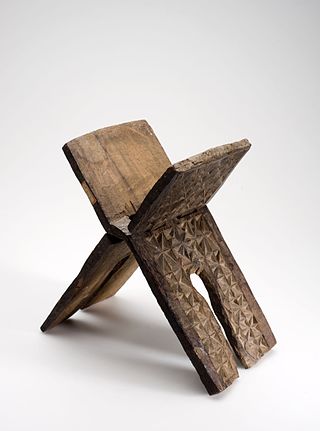
Islam is a minority religion within the Democratic Republic of the Congo, where the large majority of the population is affiliated with various Christian denominations and sects. It was first introduced to the Congo basin from the East African coast during the 19th century and remains largely concentrated in parts of Eastern Congo, notably in Maniema Province. Most Congolese Muslims are Sunni and follow the Shafi‘i and Maliki school of jurisprudence (fiqh). Though estimates vary, it is generally believed that between one and 10 percent of the country's population identify as Muslim.

The Mongo people are an ethnic group who live in the equatorial forest of Central Africa. They are the largest ethnic group in the Democratic Republic of Congo, highly influential in its north region. The Mongo people are a diverse collection of sub-ethnic groups who are referred to as AnaMongo. The Mongo (Anamongo) subgroups include the Mongo, Batetela, Bakusu, Ekonda, Bolia, Nkundo, Lokele, Topoke, Iyadjima, Ngando, Ndengese, Sengele, Sakata, Mpama, Ntomba, Mbole. The Mongo (Anamongo) occupy 14 provinces particularly the province of Equateur,Tshopo, Tshuapa, Mongala, Kwilu, in Maï Ndombe, Kongo-Centrale, in Kasai, in Sankuru, Maniema, North Kivu and South Kivu, Tanganiyka (Katanga) and Ituri province. Their highest presence is in the province of Équateur and the northern parts of the Bandundu Province(Maï Ndombe).

The Republic of the Congo is a country located on the western coast of Central Africa to the west of the Congo River. It is bordered to the west by Gabon, to the northwest by Cameroon, to the northeast by the Central African Republic, to the southeast by the Democratic Republic of the Congo, to the south by the Angolan exclave of Cabinda, and to the southwest by the Atlantic Ocean.
The Kele language, or Lokele, is a Bantu language spoken in the Democratic Republic of the Congo by the Kele people.
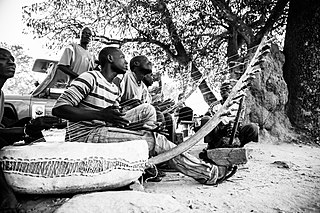
African Harps, particularly arched or "bow" harps, are found in several Sub-Saharan African music traditions, particularly in the north-east. Used from early times in Africa, they resemble the form of harps in ancient Egypt with a vaulted body of wood, parchment faced, and a neck, perpendicular to the resonant face, on which the strings are wound.

The Topoke people are an ethnic group that live in the Isangi Territory south of the Congo River, downstream from Kisangani in the Tshopo Province of the Democratic Republic of the Congo. They speak the Poke language, in the Soko–Kele languages group of Bantu languages.
The Poke language, is in the Soko–Kele languages group of Bantu languages. It is spoken by the Topoke people of the Tshopo District, Isangi Territory, in the Democratic Republic of the Congo.
The Turumbu people are a Bantu ethnic group living in the Democratic Republic of the Congo, mostly in the Isangi Territory of the Tshopo Province on both sides of the Congo River. They speak the Lombo language. As of 1971 their population was estimated to be 10,000. A more recent estimate put the population at 32,000.
Kele is a Bantu language of Gabon. Dialects of the Kele language are scattered throughout Gabon.
John F. Carrington was an English missionary and Bible translator who spent a large part of his life in the Belgian Congo. He became fluent in the Kele language and in the related talking drum form of communication, and wrote a book titled The Talking Drums of Africa.
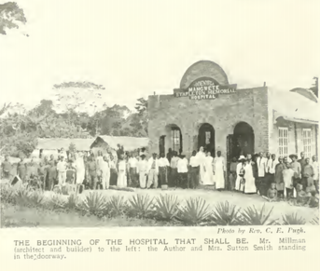
Yakusu was a mission in the Democratic Republic of the Congo, on the Congo River just west and downstream of Kisangani.
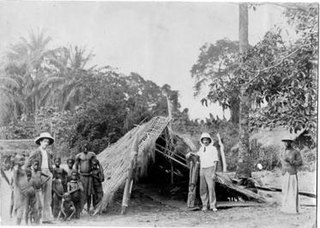
Yalemba was a mission of the Baptist Missionary Society (BMS) in the Democratic Republic of the Congo, lying on the north bank of the Congo River between Basoko and Yangambi.

The Bantu peoples are an ethnolinguistic grouping of approximately 400 distinct native African ethnic groups who speak Bantu languages. The languages are native to 24 countries spread over a vast area from Central Africa to Southeast Africa and into Southern Africa.
References
- ↑ "THE KELE (LOKELE) OF THE DEMOCRATIC REPUBLIC OF CONGO" (PDF). Jesus Film. Archived from the original (PDF) on 2012-04-25. Retrieved 2011-10-25.
- ↑ Freeman Dyson (March 10, 2011). "How We Know". NY Books. Retrieved 2011-10-25.